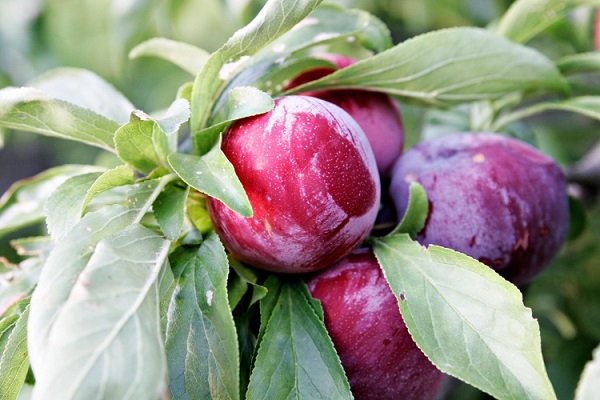Plum is a fairly common plant that can be found in every garden. You can get a good harvest of tasty and healthy fruits only from a healthy tree. However, gardeners often encounter growing problems such as plum diseases and pests that can kill the entire garden.
Table of contents
Fungal and viral diseases of plums: diagnosis and treatment
Diseases of the tree are associated with inadequate care and improper planting. Most often, the plum is affected by viral and fungal diseases that appear on weakened trees. To start treatment on time, it is important to know the main signs of the disease.
Plum bushiness or sprouting
This fungal disease in the common people received the name "witch broom." On the affected tree, many thin, short shoots are formed, which are collected in bunches. Such shoots will not bear fruit. In the fight against the disease will only help the destruction of infected plants.
As a preventive measure, not only mineral and organic fertilizers are used, but also Bordeaux liquid. In addition, in order to secure the plot, only healthy seedlings are planted in the garden. They must be purchased only in proven nurseries.
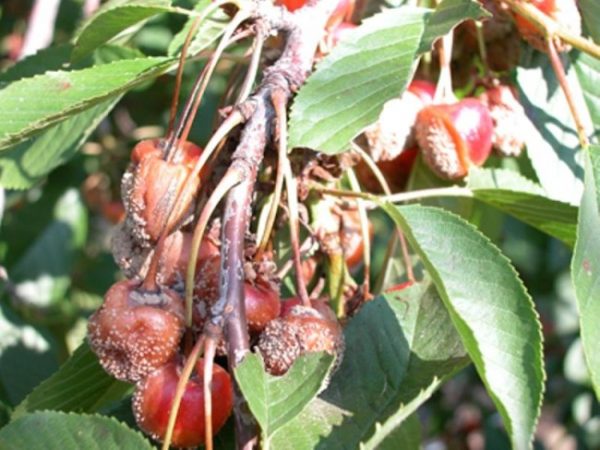
Comedication
The disease is widespread in the stone fruit cultures that were previously affected by fungi. Most often, the disease begins to develop if the irrigation regime is disturbed or too much fertilizer is applied to the soil. Resin on the tree may stand out after freezing or improper pruning. The signs of gum cure are the following:
- wounds and fissures are visible on the trunks and shoots;
- in the places where the gum flowed out, there appeared transparent frozen drops.
If time does not pay attention to the signs that have appeared, the tree may die. Affected bark is an excellent place for the development of bacteria that lead to tree cancer.
The affected areas on the trunks must be treated with a 1% solution of copper sulphate or garden pitch. Strongly affected shoots are best cut. In order to further improve the immunity of the plant and avoid re-infection, you need to properly care for the plum.
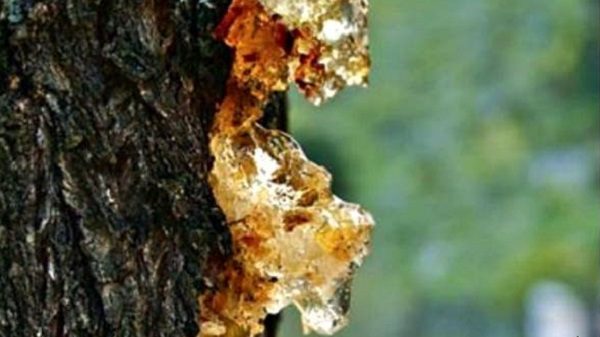
Plum dwarfism
Insidious viral disease, which occurs more often in a latent form. Determining the affected tree is difficult. Dwarfism can only appear at the last stage,when fighting disease is pointless. Therefore, all actions of the gardener should be directed rather to preventive measures.
Symptoms of the disease:
- oppressed growth of a tree;
- unnatural leaf shape. They become elongated, gnarled and more like willow leaves;
- premature abscission of leaves. This is because the leaf plate becomes brittle;
- yield reduction;
- no peduncles or a small amount of them. Flowers ugly and underdeveloped.
At the last stage of the virus development, there are practically no leaves on the branches of the tree, they are bare. Single acicular sheets can be seen only at the tips of the shoots.
Dwarfism affects not only plum, but also other stone fruit. The virus spreads along with infected planting material, parasites (mites, aphids), and a working tool for pruning.
As a preventive measure, resistant plum varieties are planted in the garden, and plants are regularly treated for pests.
Plum Pockets
Fungal disease, the causative agent of which is a voice fungus.Infection occurs in conditions of cold prolonged spring, when air humidity is high. Spores of the fungus penetrate the flowers of the tree, so the formation of ugly ovaries.
The fruits of the affected plant are unfit for food, they grow deformed. The development of the fungus occurs inside the fetus, in a kind of pocket, so there is no stone in the plums. The flesh becomes grainy and shriveled. Since the fungus affects only the fruits, the disease only appears once a season.
Methods of struggle:
- Destroy the affected shoots in the first half of summer.
- The collection and disposal of infected fruit is carried out until the spores of the fungus are dispersed.
- Prophylactic spraying of plum with 3% solution of Bordeaux mixture. The first time processing is carried out before bud break, then before flowering and after.
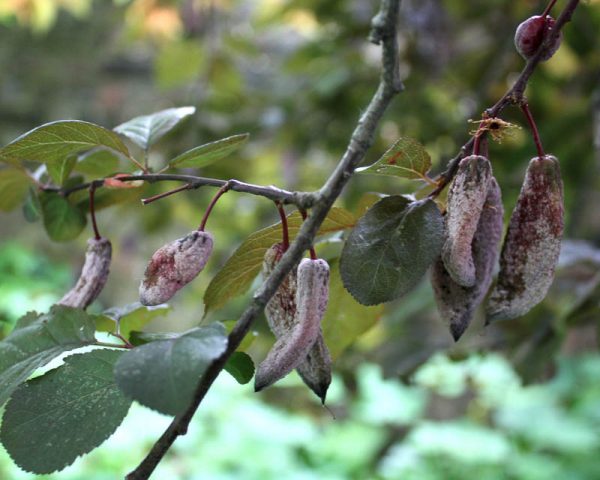
Klesterosporiosis or perforated spotting
Fungal disease develops in conditions of a long, warm, but rainy summer, when air humidity exceeds 70%.The fungus winters under the bark. Mycelium begins to develop at a temperature of +4 degrees. You can find it on the shoots or buds of the plant in the form of a dark weak plaque.
On young leaves, spores are carried by the wind and most pests. The disease spreads very quickly. Over the season, many colonies of fungi are formed, which adversely affects the condition of the tree.
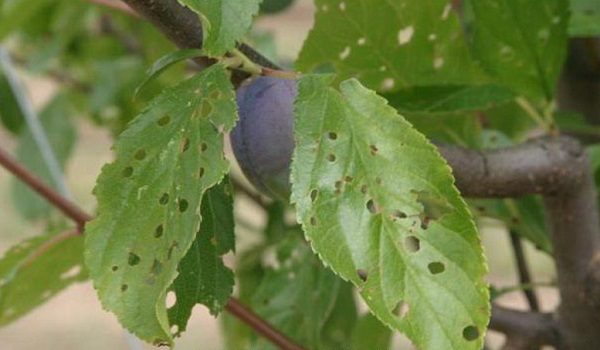
Symptoms of damage can be seen on all tissues of the plant, but most often they appear on young leaves.
- Small round spots of various colors, which increase in size in a short time.
- In the center of the stain the tissues die off, which leads to the formation of holes in the leaves.
- The edges of the holes have a reddish border. This is the main symptom of phytosteriasis, which distinguishes it from other types of blotch.
- With a neglected disease, the bark of the tree is covered with orange-red spots with a dark border. Subsequently, they are pressed into the trunk, burst and lead to the flow of gum.
- Gum is also flowing from affected buds and shoots., which leads to their extinction and lower yields.
- Fruits are affected by ulcers, become one-sided, shrink, harden and fall off. Gum can flow from them too.
For the prevention of the disease, in the autumn they are cleaning the garden, digging near-trunk circles of the tree, destroying the shoots, collecting and utilizing the affected fruits and fallen leaves. In addition, it is important to treat the wounds and cracks in the tree in time, avoiding gum therapy. For processing use a solution of copper sulfate, manganese or garden var.
In the fight against the fungus will help spraying the tree during the growing season. Treatments begin in early spring, repeated in deep autumn. Use drugs Kuproksad, Scor, Horus, Topaz or Vectra. The last treatment is carried out 20 days before harvest.
Monilioz
The causative agent of the disease is the fungus monilia. Infection of the tree occurs during flowering, if there are drops or a decrease in temperature. Cold spring weather only speeds up the process. Spores penetrate the plant tissue through the pestle, gradually hitting the whole tree.
Signs of defeat:
- dramatic abscission of flowers;
- drying of peduncles and adjacent leaves;
- old shoots and branches crack; gum flows out of the formed wounds;
- the whole tree looks “burned”.
The disease extends not only to the fruits, but also to the shoots, plum leaves.The pathogen overwinters in the affected tissues of the tree. Prevention of moniliosis begins in the fall. All affected shoots are cut out and the garden is treated with Hom, Bordeaux liquor or copper oxychloride. For spraying one tree will need up to 4 liters of solution.

Smallpox on plum
Sharka, in common the smallpox of the plum, is a viral disease. Manifested on the young leaves of the tree in the form of chlorosis, spots or stripes. Over time, the leaves acquire a characteristic marbling, they appear light areas. If you do not take any measures, the disease passes to the fruits. They become spotty, the pulp grows coarse and loses its taste. In addition, the spots begin to deepen into the fetus. Diseased plums ripen ahead of schedule, fall off or dry out directly on the tree.
Unfortunately, it is impossible to fight the disease. All affected trees must be burned. Control measures are only prophylactic, aimed at the timely treatment of the garden from pests that can spread the virus.
Rust
In July, on young plum leaves, you can notice rust spots, which gradually increase in size.Affected trees shed their leaf cover earlier. Leave the plum in this state is impossible. The winter hardiness of the plant and the future harvest are sharply reduced.
In order to prevent trees treated with copper oxychloride before and after flowering. In the autumn, after harvesting, spraying is carried out with a 1% solution of Bordeaux mixture.
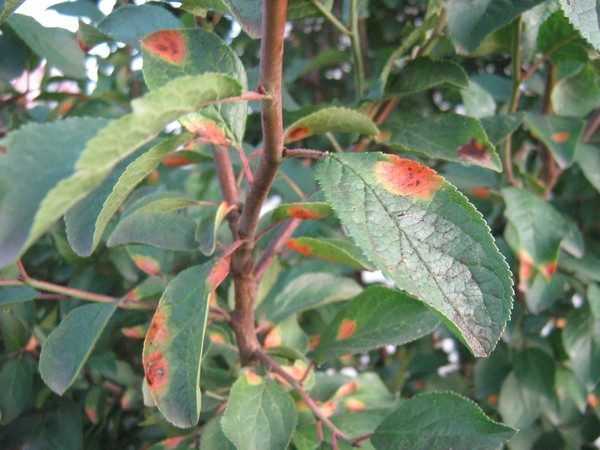
Plum coccomycosis
Dangerous fungal disease that affects the leaves of the tree, at least - the fruit and young shoots. The first signs of the disease are noticeable in early summer.
- The leaves are covered with small, red-brown spots.
- On the back of the sheet can be found whitish bloom. This is the spores of the fungus.
- The leaves are rapidly turning yellow and fall off.
- Fruits do not develop, become watery and fall off.
Most often the disease develops in warm and humid weather, reduces the hardiness of the tree. The fungus overwinters in the fallen leaves, so in the fall it must be collected and burned. In addition, the tree trunk is sprayed with copper or Bordeaux preparations.
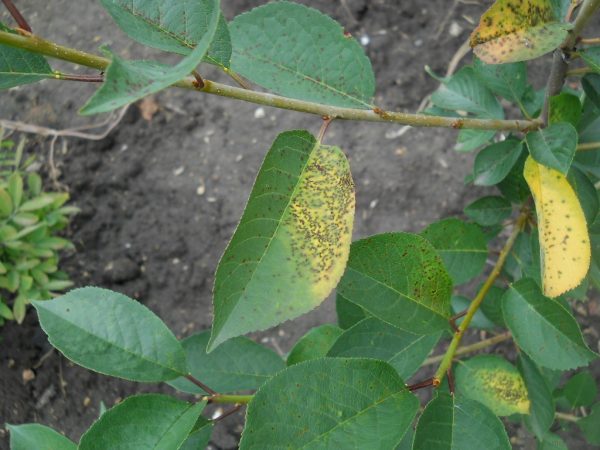
Root cancer
Recently, the disease is frequent.The cause of its occurrence is pathogenic bacteria in the soil, which penetrate into the plant tissue through cracks in the roots. On the infected plum roots, specific growths are formed, which leads to the death of the tree. Contributes to the development of the disease severe drought and weak alkaline environment.
As a preventive measure, the garden is located in a place where no outbreaks of the disease had previously been observed. Severely affected seedlings destroy. The landing site is disinfected with a solution of copper sulphate.
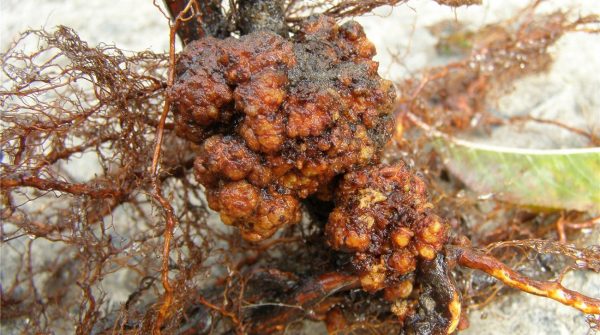
Plum tinder
Dangerous fungal growths on the bark of a tree. Penetrating through small cracks in the bark, spores destroy the wood. Hollows are formed on the affected places. After a few years, a solid fungal body grows instead. Sometimes it looks completely harmless.
To prevent infection of the tree, you need to carefully handle the wounds and cracks in the bark of the sink. Fruit bodies of the fungus are destroyed before the spores spread, as a rule, in early June. The remaining wounds are cleaned of decay, washed with a solution of copper sulphate, and then poured with a mixture of cement and sand (1: 4).

Gall mite
This is a bizarre insect that settles near the fruit buds of plums in growths - galls. In one galle can be up to 400 insects. At the end of May, overwintered individuals come to the surface of the bark and feed on the plant sap. In places of bites on the bark reddish growths are again formed, where females lay eggs. In one season more than one generation of pests grows. Determine the defeat of plums gall mite can be characteristic ugly growths.
To fight insects need immediately after flowering plum. Conduct several treatments with colloidal sulfur preparations. In case of mass destruction, it is recommended to cut and burn the shoots.
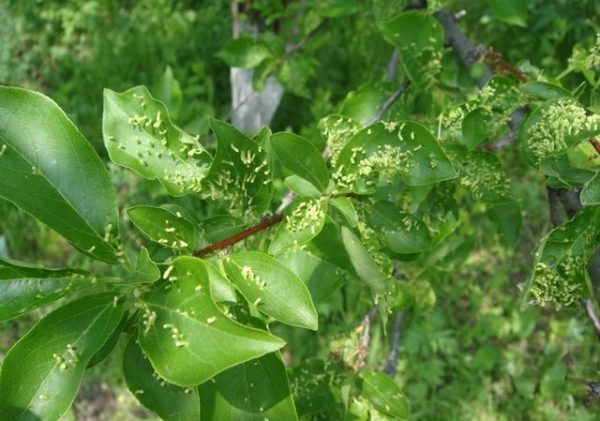
Zlatoguzka
It is a white butterfly, the abdomen of which is covered with yellowish hairs. The pest caterpillars overwinter in fallen leaves. After the blooming of the plum buds, the gold-wisper begins to harm, actively eating them. Butterflies are nocturnal, laying eggs on the surface of leaves. The caterpillars that appear are very voracious, in a short time they cause great damage to young leaves. They eat holes in them, slowing down the normal growth of the plant.
In order to fight insects, spraying trees with karbofos solution is carried out. In the autumn, the struggle with the gold-and-tails is not stopped. Collect fallen leaves, loosen the soil under the trees, thereby destroying the pest nests.
Plum moth
This gray-brown butterfly harms plum fruit. Its reddish caterpillars hibernate under the bark of a tree or in the upper soil layer. In early spring, butterflies lay eggs in green fruit. When the caterpillars appear, they feed on the pulp of the fruit, and then go to wintering grounds. Affected plums acquire a purple hue and fall off, often gum drops can be seen on them.
Against the plum moths, prophylactic sprays of karbofos are carried out, trappers are put on trees, and the soil is regularly loosened.
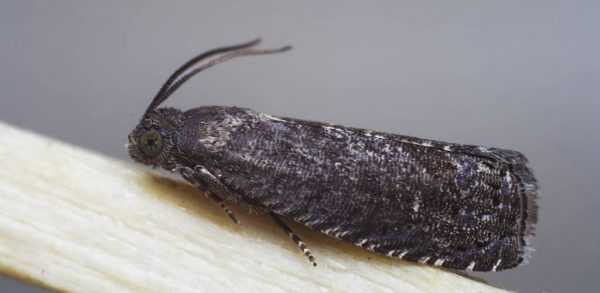
Aphid on tree
Small insect of pale green color that sucks cellular sap. You can determine the presence of aphids with the naked eye:
- shoots tops twisted;
- the tree is stunted;
- pour dry and fall;
- small insects are visible on the back of the leaf.
At the beginning of the growing season, the plum is treated with preparations against leaf-eating and sucking insects. Spraying is repeated after 10–14 days. The first treatment is carried out "on the green cone."
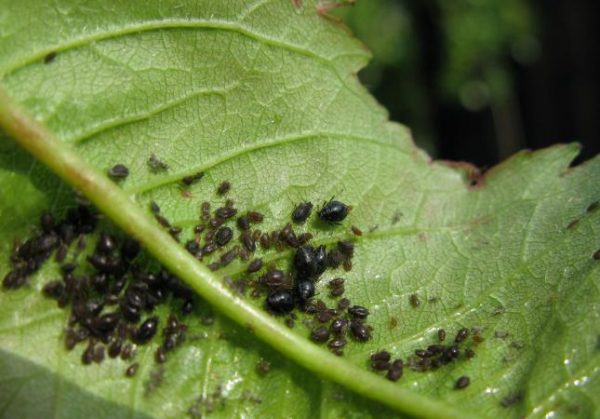
Hawthorn
White butterfly, which is diurnal. Its caterpillars feed on buds, leaves, buds and plum blossoms. The methods of struggle are the same as with gold-tails, plum moths.
Why do worms appear in plum fruits?
Very often gardeners complain that almost the entire crop of plums is wormy. Why does it happen that causes damage to the fruit?
Plum sawfly and worm fruits
The larvae of this insect destroy the plum still green. They eat not only the bone, but also the pulp of the fruit. As a result, the cream fall immature, but wormy. To get rid of parasites will have to try and remove the painful fruit.
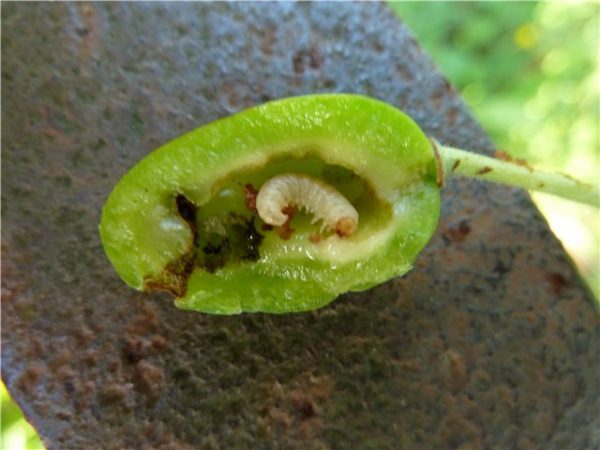
Plum weevil on leaves
Females of this insect eat buds and plum flowers, biting into the ovary. There they lay the larvae, which eat the fruits from the inside. The harvest is all spoiled. For the winter, the larvae and beetles go to the soil. Trees should be treated in the spring.
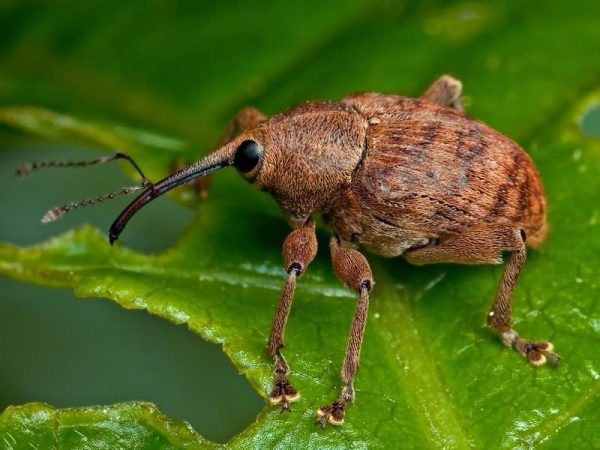
How to get rid of fruit worms in plum
Treating trees in the garden should be as early as possible, without waiting for the pests to start work and the fruit will rot. The first treatment should be carried out in early spring. Re-spray plum need before flowering and after it. If the number of pests is very large, then the treatment is repeated at intervals of 10 days. But the latter should be held no later than 25 days before harvest.
To prepare the working solution using drugs Phosphamide, Dursban, Metaphos, Bordeaux liquid or iron sulfate. With a small number of insects spraying make infusions of tobacco, wormwood, dandelion or ash. Infusions are prepared in different ways.
How to deal with plum pests: preventive treatment
Every gardener knows that it is easier to prevent illness than to cure a garden. Therefore, prevention should always be.
- Every tree needs good care., regular watering and dressing.
- They regularly sanitize the garden, cut out thickened branches, remove fallen leaves and dig up the soil.
- In the spring and autumn they spray not only the tree, but also the soil under it.
It is very important that all actions are permanent. If a neighbor’s garden is affected by worms, scab, coccomycosis, or curly, then it’s time to get to work and process your own trees. You should not hope for "maybe blow over."
Conclusion
To reduce the risk of damaging trees with insects and various diseases, it is necessary to regularly inspect the garden. In addition, to carry out prevention, and at the first signs of the disease to take immediate action. This will increase not only the yield of plums, but also the quality of the fruit.
